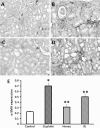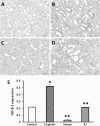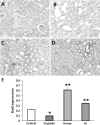Nephroprotective effect of bee honey and royal jelly against subchronic cisplatin toxicity in rats
- PMID: 25720368
- PMCID: PMC4960153
- DOI: 10.1007/s10616-015-9860-2
Nephroprotective effect of bee honey and royal jelly against subchronic cisplatin toxicity in rats
Abstract
Cisplatin is one of the most potent and effective chemotherapeutic agents. However, its antineoplastic use is limited due to its cumulative nephrotoxic side effects. Therefore, the present study was undertaken to examine the nephroprotective potential of dietary bee honey and royal jelly against subchronic cisplatin toxicity in rats. Male Wistar rats were randomly divided into controls, cisplatin-treated, bee honey-pretreated cisplatin-treated and royal jelly-pretreated cisplatin-treated groups. Bee honey and royal jelly were given orally at doses of 20 and 100 mg/kg, respectively. Subchronic toxicity was induced by cisplatin (1 mg/kg bw, ip), twice weekly for 10 weeks. Cisplatin treated animals revealed a significant increase in serum level of renal injury products (urea, creatinine and uric acid). Histopathologically, cisplatin produced pronounced tubulointerstitial injuries, upregulated the fibrogenic factors, α-smooth muscle actin (α-SMA) and transforming growth factor β1(TGF-β1), and downregulated the cell proliferation marker, bromodeoxyuridine (Brdu). Dietary bee honey and royal jelly normalized the elevated serum renal injury product biomarkers, improved the histopathologic changes, reduced the expression of α-SMA and TGF-β1 and increased the expression of Brdu. Therefore, it could be concluded that bee honey, and royal jelly could be used as dietary preventive natural products against subchronic cisplatin-induced renal injury.
Keywords: Cisplatin; Honey; Nephrotoxicity; Rat; Royal jelly.
Figures




Similar articles
-
Effect of Honey and Royal Jelly against Cisplatin-Induced Nephrotoxicity in Patients with Cancer.J Am Coll Nutr. 2017 Jul;36(5):342-346. doi: 10.1080/07315724.2017.1292157. Epub 2017 May 26. J Am Coll Nutr. 2017. PMID: 28548561
-
Nephroprotective efficacy of ceftriaxone against cisplatin-induced subchronic renal fibrosis in rats.Naunyn Schmiedebergs Arch Pharmacol. 2017 Mar;390(3):301-309. doi: 10.1007/s00210-016-1332-5. Epub 2016 Dec 14. Naunyn Schmiedebergs Arch Pharmacol. 2017. PMID: 27975300
-
Anti-Inflammatory, Anti-Apoptotic, and Antioxidant Roles of Honey, Royal Jelly, and Propolis in Suppressing Nephrotoxicity Induced by Doxorubicin in Male Albino Rats.Antioxidants (Basel). 2022 May 23;11(5):1029. doi: 10.3390/antiox11051029. Antioxidants (Basel). 2022. PMID: 35624893 Free PMC article.
-
Bee Venom, Honey, and Royal Jelly in the Treatment of Bacterial Infections of the Oral Cavity: A Review.Life (Basel). 2021 Nov 28;11(12):1311. doi: 10.3390/life11121311. Life (Basel). 2021. PMID: 34947842 Free PMC article. Review.
-
Bee-Derived Products: Chemical Composition and Applications in Skin Tissue Engineering.Pharmaceutics. 2022 Mar 30;14(4):750. doi: 10.3390/pharmaceutics14040750. Pharmaceutics. 2022. PMID: 35456584 Free PMC article. Review.
Cited by
-
Phenolic Compounds of Propolis Alleviate Lipid Metabolism Disorder.Evid Based Complement Alternat Med. 2021 Feb 20;2021:7615830. doi: 10.1155/2021/7615830. eCollection 2021. Evid Based Complement Alternat Med. 2021. PMID: 33688365 Free PMC article.
-
Deferiprone ameliorates cisplatin induced peripheral neurotoxicity via ferritinophagy adjustment.Sci Rep. 2025 Feb 6;15(1):4485. doi: 10.1038/s41598-025-87628-x. Sci Rep. 2025. PMID: 39915547 Free PMC article.
-
Royal jelly a promising therapeutic intervention and functional food supplement: A systematic review.Heliyon. 2024 Aug 30;10(17):e37138. doi: 10.1016/j.heliyon.2024.e37138. eCollection 2024 Sep 15. Heliyon. 2024. PMID: 39296128 Free PMC article. Review.
-
Cisplatin chemotherapy and renal function.Adv Cancer Res. 2021;152:305-327. doi: 10.1016/bs.acr.2021.03.008. Epub 2021 Apr 28. Adv Cancer Res. 2021. PMID: 34353441 Free PMC article. Review.
-
Protective effect of royal jelly against diclofenac-induced hepato-renal damage and gastrointestinal ulcerations in rats.Heliyon. 2020 Feb 1;6(2):e03330. doi: 10.1016/j.heliyon.2020.e03330. eCollection 2020 Feb. Heliyon. 2020. PMID: 32025584 Free PMC article.
References
-
- Abdel-Daim MM. Pharmacodynamic interaction of Spirulina platensis with erythromycin in Egyptian Baladi bucks (Capra hircus) Small Rumin Res. 2014;120:234–241. doi: 10.1016/j.smallrumres.2014.05.013. - DOI
-
- Abdel-Daim MM, Ghazy EW, Fayez M. Synergistic protective role of mirazid (Commiphora molmol) and ascorbic acid against tilmicosin-induced cardiotoxicity in mice. Can J Physiol Pharmacol. 2014 - PubMed
LinkOut - more resources
Full Text Sources
Other Literature Sources

